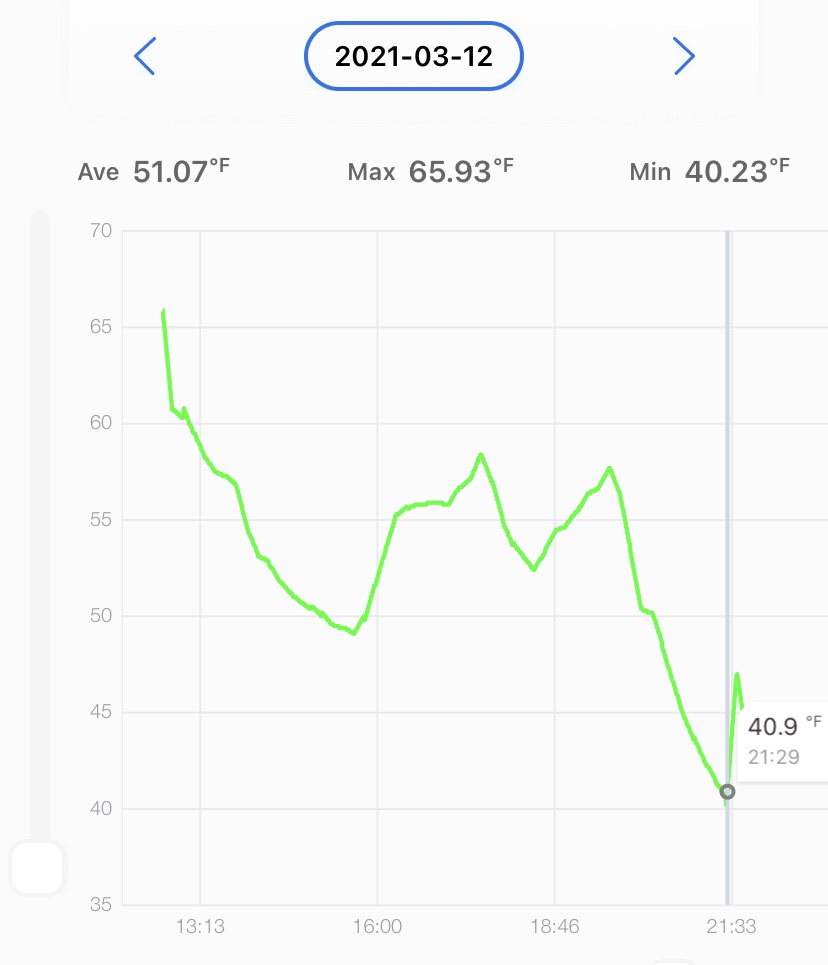I had the data, so I thought that I would share this.
On the eve of a large snowstorm here in Colorado, I found that my fridge just wasn’t working. It has been struggling for a while, but it finally reached a point where the refrigerator part was not cool at all. That’s when I started messing with it.
First dip, 12:30pm-3:30pm

I initially tried to chill the refrigerator down with ice packs for about three hours. I was working, and wanted to get to it later. I used a small Bluetooth Inkbird sensor reader that I had initially gotten for homebrewing. It didn’t make the cut for that, but this seemed like the perfect application for this crisis. The data was recorded minute by minute, and accessible through an app on my phone.
First rise, 3:30pm-5:30pm

The ice seemed to be stalling. This is when I tried to clean everything in the freezer above to see if that would solve anything. The temperature gradually rose back to where I started.
Second dip, 5:30pm-6:30pm

My work didn’t seem to fix anything. I threw in a few ice packs anyway and brought the temperature down slightly. This was looking to be very bad. I finally decided that I had to throw out all of my fresh food; there was no way that it hadn’t spoiled by now.
Second rise, 6:30pm-7:30pm

Now that I didn’t have anything else to lose, I placed all of my frozen food into an insulated bag with ice packs, and unplugged the fridge. I deduced that the freezer was somehow stopping the fridge from cooling because of ice buildup in other areas that I had been seeing over previous days. I decided to try to defrost the freezer with a metal kettle and a stainless steel container filled with hot water against the back wall. Through some Googling, I found out that people typically use hair dryers to do this. I used radiant heat, because I didn’t have that. I thought about the old houses that I had lived in previously that had radiators, and it just made sense to me.
I waited for a few minutes. After some adjustments, water poured out of the drip tray in the back of the fridge for about an hour until it tapered off. I put paper towels underneath to catch about two cups of water, I estimated. I chalked this problem up as being a possible failure of the freezer’s auto defrost feature, and manual defrosting was also not suggested in the user guide that I looked up. Plugging the fridge back in, I begin the chilling process again by flipping the breaker to kick on the compressor inside. I put the frozen food back into the freezer, and all of ice onto a shelf on a fridge shelf as a last resort to get anything else going.
Third dip, 7:30pm-9:22pm

It was initially hard to tell if the ice was the star again here, but after a while, I could tell that this temperature drop was much more rapid than before.
When it dropped below 49 degrees, I knew that I had figured it out.
For almost two hours, the fridge worked it’s way down to just above 40 degrees. The slight rise at 9:29pm is when I got what I thought was a poorly timed grocery delivery that I put in a day before. I was actually angry because I thought it was between 9-11 AM instead of PM, but this turned out to be serendipitous. It was just in time for the winter storm here in Colorado, as people had probably been flooding the service just as they were crowding grocery stores.
I can now, two days later, report that: the fridge is chill, my keg with homebrewed beer is cold (and delicious), and all is well.
